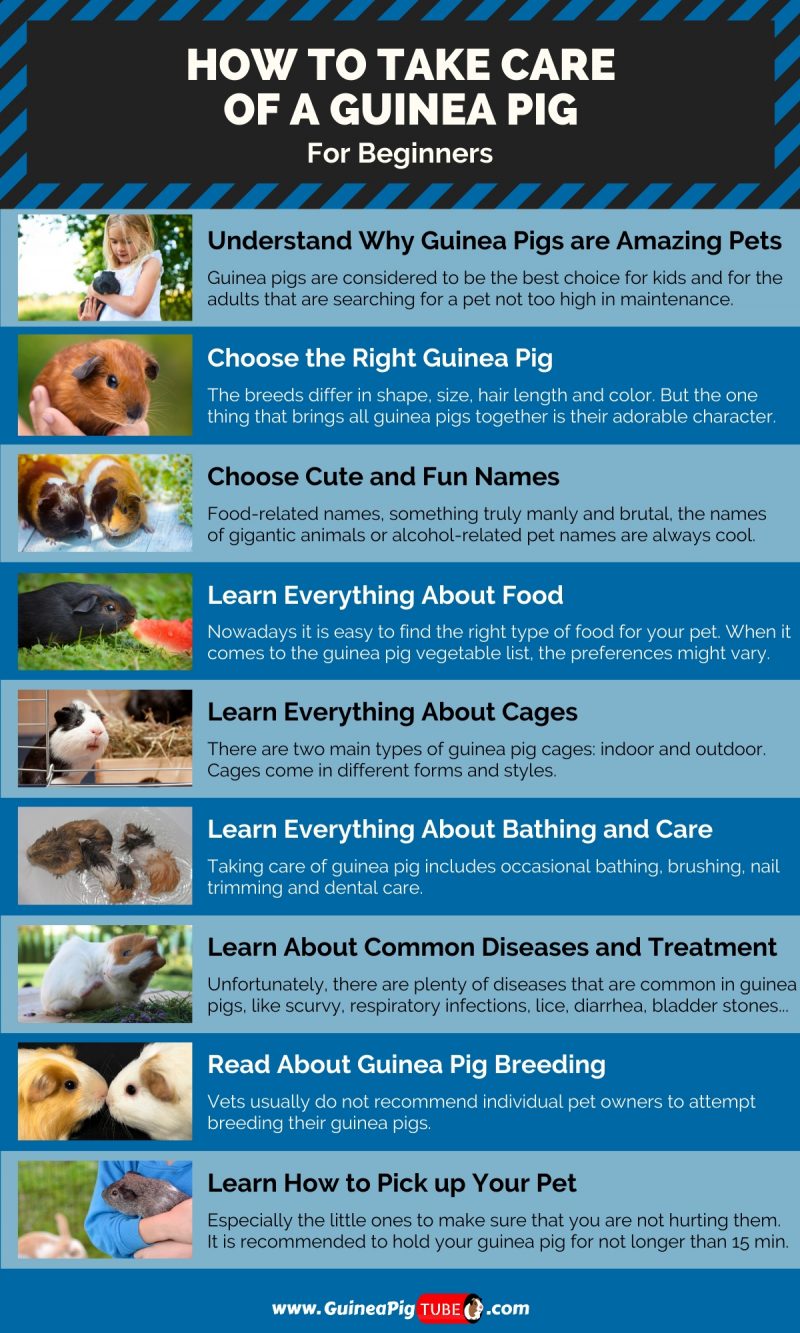Have you decided to get a guinea pig as a pet? It is a great idea! But even though with guinea pigs caring is kept to a minimum, there are still plenty of things that you need to know.
But just like any other type of pet, guinea pigs need to be taken care of if you want them to be happy and healthy. You should be aware of the breed that is suitable for you and the name that they must be given when taking care of them. You should also understand the appropriate cage size, the food to feed them, and how to treat any illnesses they may contract.
How to Take Care of a Guinea Pig for Beginners? | 9 Essential Ways
1. Why Do Guinea Pigs Make Amazing Pets?
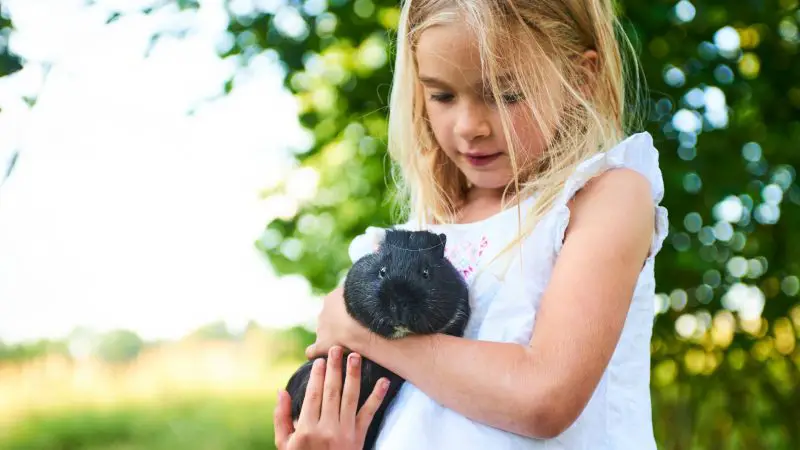
Getting a cat or a dog might be a dream for some, but it is so hard to find enough time for these demanding animals. Guinea pigs, however, are considered to be the best choice for kids and for adults that are searching for a pet not too high in maintenance.
Owning a guinea pig for the first time will surely be a wonderful journey. These animals are cute and cuddly. They are extremely easy to take care of and live up to 7 years.
Guinea pigs make sweet noises and like to be petted and treated. They even smell nice! If you are looking for an option to help your child start learning about pet care, guinea pigs are the ideal choice.
2. How to Choose the Right Guinea Pig?
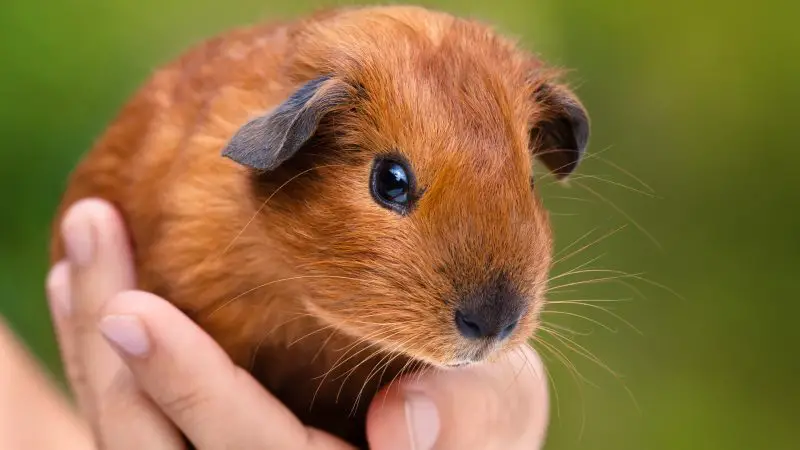
There are a lot of different breeds of guinea pigs. The breeds differ in shape, size, hair length, and color. But the one thing that brings all guinea pigs together is their adorable character. So, no matter what breed you decide to choose, you will surely be getting a friendly little companion.
Here are the most common guinea pig breeds:
- Abyssinian – These ones have middle-length hair with cute swirls. The Abyssinians also have a fun and sometimes a bit naughty personality.
- Peruvian – This breed has long straight hair. It is considered to be the most curious type that likes to come out to greet you.
- American – The most common breed of guinea pigs. They are extremely easy to take care of because of their short hair and friendly temper.
- Teddy – This breed literally looks like a real-life stuffed animal. They have a short yet dense coat and they may not appear to be as soft as the other breeds.
- Himalayan – People also like to call this breed ‘albino’. They are actually not as rare as you might think; they have color on their feet, ears, and noses; these black points might disappear if you expose the guinea pig to direct sunlight for too long.
- Texel – This breed has curly soft hair all over the body, even the belly. This is the right choice for those who want to show off their guinea pigs.
- Skinny Pig – This guinea pig has only a little bit of hair on his feet and legs. All the other parts are completely hairless. Maybe not the cutest breed, but still very friendly.
As you might have already figured out, the only thing in which all these breeds differ from each other is the length of their hair. The longer the hair, the more points your guinea pig care sheet will include, so choose wisely.
If you want to buy only one guinea, it doesn’t really matter if it’s a boy or a girl. However, the two boys might be fighting a lot, as well as a boy and a girl. Picking two girls is a great idea if you want them to live in harmony.
When choosing a guinea pig, take a look at its overall appearance. It has to look healthy. The ears, eyes, and noses have to be clean. Make sure that there are no crusty sores and that the animal is not bleeding. Fold back some hairs of the guinea pig’s back to see if there are any flakes, sores, redness, fleas, or lice.
3. Cute and Fun Name Ideas
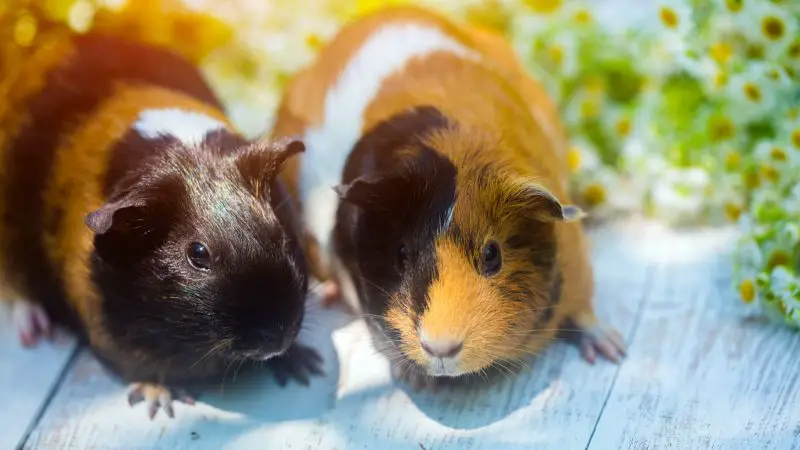
Are you looking for some cool guinea pig names? Here are a few fun ideas:
1. Food-related names are always at the top of the list. Cookie, Milkshake, Meatball, Lasagna, Butter, Ham, or whatever you prefer. These go great both for boys and for girls.
2. Something truly manly and brutal. For example, the name of your favorite rock band or its lead singers, such as Ozzy, Axel, Metallica, Jagger, and Joplin.
3. The names of gigantic animals because guinea pigs are so tiny and cute, such as Godzilla, T-Rex, and Tiger.
4. It doesn’t matter if you like to have a drink or two or if you’re the one who chooses soda at a party. Alcohol-related pet names are cool, such as Tequila, Rum, Guinness, and Vodka.
Also, you can read our recommended lists of the best female guinea pig names and male guinea pig names if you’re having trouble choosing a perfect name for your cute little pet.
4. Everything About Food
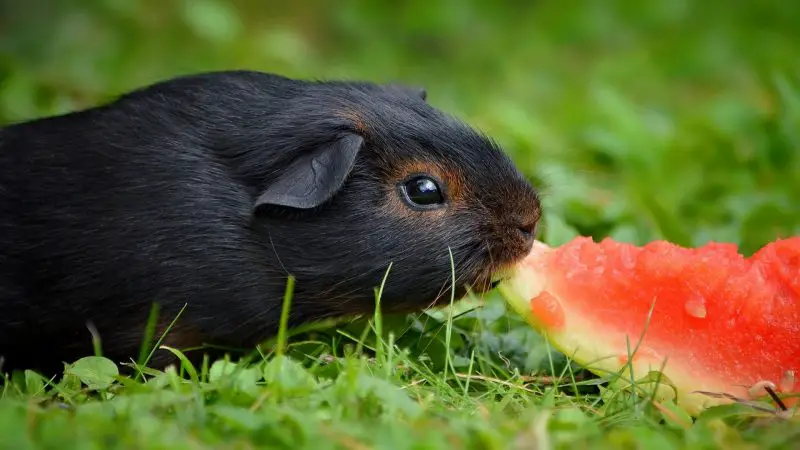
Guinea pigs’ natural diet consists of leaves, seeds, and stems. Even in cages, guinea pigs love to nibble on fresh grass and hay. But it is a lovely idea to add fruit and vegetables to their diet as well.
If your pet is placed outside, it will be amazing if you invest in a grazing cage. The guinea pig will be able to eat as much fresh grass as it wants.
Nowadays, it is so easy to find the right type of food for your pet. Specialized shops have all sorts of different things that you can treat your guinea pig with. Simply don’t forget to pay attention to the packaging to make sure that you don’t buy rabbit pellets.
When it comes to the guinea pig vegetable list, the preferences might vary. All breeds tend to love carrots, spinach, corn, and lettuce. Try avoiding cabbage, broccoli, and cauliflower, as they can lead to gas production. Don’t get me wrong, they can eat these vegetables but in larger quantities, they can cause stomach problems.
A lot of these tiny guys love apples and orange peels. But the truth is that the taste of every individual guinea pig might vary. You can’t say for sure what guinea pigs like to eat. Some adore tomatoes and others don’t.
Guinea pigs should have access to water at all times. Buying a water dispenser is not necessary. You can totally make one yourself with the help of a soft drink bottle, a wire, and a metal tube.
Homemade Guinea Pig Treats
Unfortunately, store-bought treats might be too expensive. But if you still want to make your fluffy friend happy, here are a few great recipes that you can try out. Bear in mind that some guinea pigs might not like the recipe, but you should always continue trying to find out what kind of foods your pet prefers.
The following are the ingredients and ways to make homemade guinea pig treats called yummy squares:
- 1 cup oat flour
- 1 cup cavy
- 2/3 cup water or vegetable broth
- 6 tablespoons of any vegetable oil
- 2 tablespoons of honey
Mix all the ingredients together. Roll them out and cut them into small pieces. Bake in the oven at 350 degrees for about 20 minutes. The treat has to become firm. Let the goodies cool. You can also add sunflower seeds or carrots.
Vitamins

Vitamin C is the only vitamin that your pet will need. Guinea pigs tend to get all their vitamins and minerals from the food that they eat or they are able to produce the substance on their own. But when it comes to vitamin C, guinea pigs are unable to manufacture it in their bodies. That is why it is extremely important to provide your beloved pet with enough sources of this vitamin.
If a guinea pig is deprived of vitamin C, it might become ill with scurvy. Certainly, the amount of vitamin C your pet needs might vary. Pregnant, ill, and newborn guinea pigs need a bigger amount. But usually, a grown-up healthy animal requires around 10-30 mg daily.
If you want your pet to be healthy, these facts should become your guinea pig basics. The truth is that it is not that hard to make sure that your pet gets enough vitamin C. If you feed it with fresh fruits and vegetables and a fresh guinea pig pellet, the chances are high that the vitamin level is fine. But remember that vitamin C can easily disintegrate over time.
That’s why no matter how good a guinea pig pellet is, it has to be stored in a cool, dark place and you should make sure to buy new product batches regularly.
There are also special supplements that you can give to your animal. A lot of guinea pigs might like taking vitamin C tablets as a treat. Or you can always sprinkle it over their meal.
There is also an option of adding vitamin C to the water. Simply add some orange juice. But the trick here is that the good properties don’t last for long. You would need to change the water at least twice a day.
5. Everything About Cages
There are two main types of guinea pig cages: indoor and outdoor.
Indoor Cages
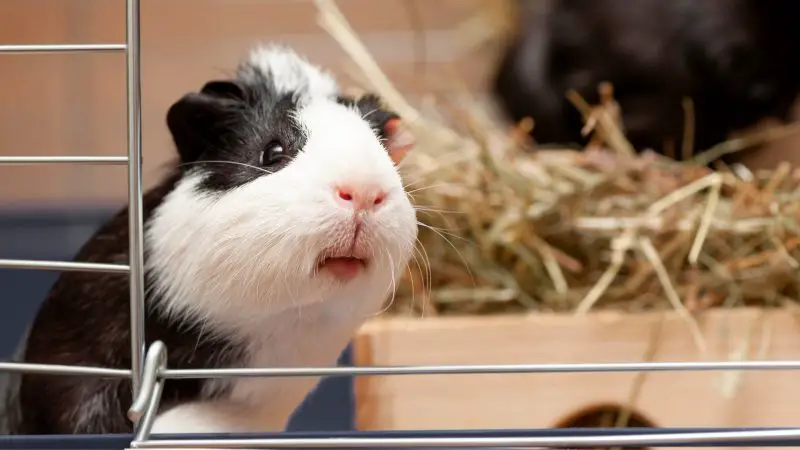
Nowadays cages come in different forms and styles. You might surely get lost while choosing one. The main things that you have to take into consideration are these:
- Is there air ventilation?
- Can you easily add a water dispenser?
- Is the cage big enough for the number of guinea pigs that you have?
- Will it be easy for you to clean out the floor?
The majority of people choose not to splurge on an indoor cage. You can easily make one yourself. Use a large plastic storage container and add a few holes to ensure proper ventilation. Take care of the place where you will be attaching the water dispenser.
For the floor of the cage, newspaper, sand, and sawdust are the most widely used options. Bear in mind that you would have to find a place for food containers and some hay that the guinea pigs will be used as a bed.
Outdoor Cages
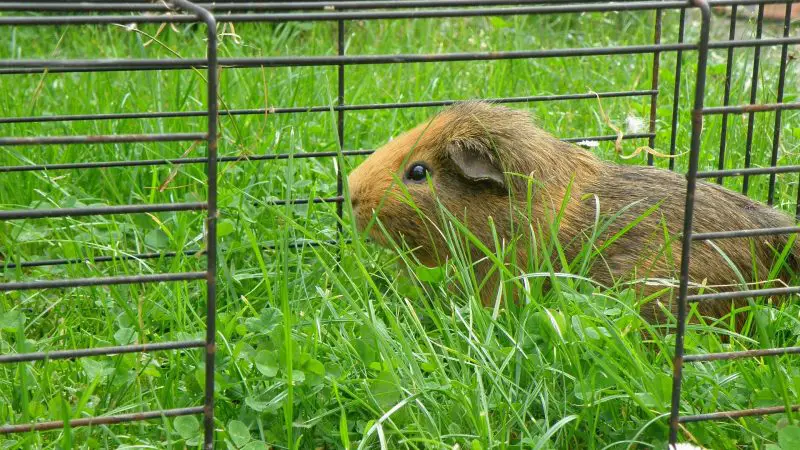
If you live in a place with a great climate, let your guinea pig enjoy the things that nature has to offer. Outdoor cages usually don’t have a floor. That’s why your pet can easily eat fresh green grass. Having such a cage will also help you overcome the problem of cleaning up. Guinea pig droppings are a great fertilizer.
You have to make sure that the cage is heavy so that different predators won’t be able to lift or turn it over. Moreover, the little lads have to have a place to hide. If a neighbor’s cat decides to pay an unexpected visit, the poor animal may die of fright.
Certainly, even outdoor cages need water dispensers. But you can easily forget about food containers.
Related: What Guinea Pig Cage Size Is the Best? (Proper Accommodation)
Cleaning Tips
One of the main reasons why people choose to get a guinea pig is because even cleaning its cage is extremely simple and won’t require a lot of time. All you have to do is clean the floor of the cage once a week. Replace the old sand, sawdust, or newspaper with fresh ones.
If you have an outdoor cage, you might not need to clean them at all! But don’t forget about the shelter’s floor, if you have one.
Cage Essentials
Getting only a cage is not quite enough. The following are some essentials that you have inside the cage:
1. Food Dish
It can be either a small bowl or a special feeder. Getting the latter might be a bit more expensive, but in the long run, it will actually help you save money. Your pets won’t be spilling anything and the food won’t be getting any dirt in it.
2. Water Bottle
You always have the option to use a simple bowl. But to go the extra mile with guinea pig care, you better get a water bottle. The water should always be clean and it is easy to add more. A water bottle is great if you want to track how much your guinea pig drinks during the day.
3. Bedding
The first type of bedding is made of wood shavings. It is the cheapest option, but not the worst one. It is easy to find such bedding and it absorbs everything well. The only downside – older guinea pigs might find wood shavings a bit uncomfortable, as they usually have problems with their feet.
Another option is getting bedding made of fiber or paper. They come in all sizes and textures. Your guinea pig will surely find such bedding softer and all-in-all more comfortable. Fiber and paper options absorb odor well, but they are pricier than wood shavings.
These are the most popular guinea pig beddings:
You can always choose to mix the two options to let your pet decide where they wants to sleep today.
Related: How to Make Guinea Pig Fleece Bedding? | DIY Guide
4. Hutches or Mini-Caves
Guinea pigs are tiny animals that can’t really defend themselves. That’s why it is in their nature to hide in a safe place every time something scary happens. Hutches and mini caves will become great shelters for them.
If you are afraid that your beloved pet will start nibbling on plastic, You can always buy an eatable hutch made out of twigs and hay. Certainly, you would have to replace this one from time to time, but your guinea pig will love it.
5. Toys
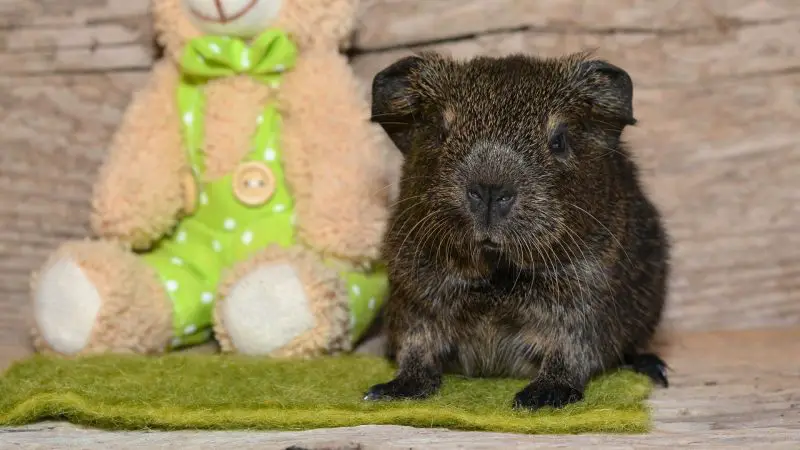
If you want to find out how to get your guinea pig to love you, you should surely think about his entertainment. The great news is that it is extremely easy and budget-friendly to make this little guy excited. The following are some toys you can have:
- A big cage – Simply having a big cage is enough to keep your pet occupied. It is the best way to make a guinea pig run, just have enough space.
- Tunnels – Guinea pigs love these as they can run through them and hide. There is a wide variety of tunnels in any pet shop. But you can always literally place a cardboard tube into the cage and your little friend will enjoy it. This is the most popular example of handmade guinea pig toys.
- A piece of paper – A crumpled piece of old paper will keep the animal entertained for hours.
- A stuffed sock – There is surely an old sock without a pair lying somewhere in your place. Fill it with your guinea pig’s clean bedding material and tie the sock on the end. A great cuddle toy is ready. The chances are high that your guinea pig will take the sock to his little house and chew on it from time to time.
- Ping-Pong balls – These things can become wonderful toys for your pet to toss around.
- Mirrors – It has to be placed outside the cage. Or you can always buy a pet-safe mirror that can be inside the cage. Guinea pigs will spend hours playing with their reflection.
You can always get creative and crafty with your pet’s toys. But remember that safety has to always come first. Small details and the majority of artificial materials can be dangerous.
Sometimes a guinea pig may get bored after a while. So don’t forget to switch the toys and come up with new ideas once in a while.
Related: Best Guinea Pig Toys: A Helpful Guide
6. Bathing and Care
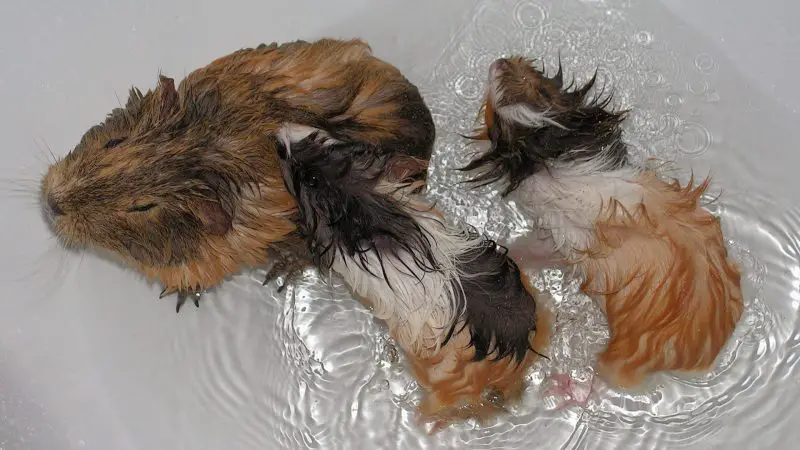
Taking care of a guinea pig is easy. All you need to do is bathe the fluffy guy once in a while. If it is hot outside, a cool bath will help your guinea pig handle the high temperature. But remember that these pets don’t really like bathing. So you would have to hold the little one tight while placing it in a shallow water container.
Here is a little more useful guinea pig info. Don’t use different chemicals simply to make your pet smell nice. It might be dangerous. But you can use different medical shampoos while bathing.
Generally, after bathing, a dry towel is everything you are going to need. But if it is cold outside, don’t be afraid to use a hairdryer.
Brushing
Certainly, if you have a longhaired breed, you would have to brush it from time to time to make sure that there are no knots. Brushing the breeds with short coats is not necessary, but you can always do that to ensure that your pet has no lice.
A narrow-toothed comb is a perfect option for guinea pigs, as a wide-toothed one might not do the job properly. Fine-toothed combs for cats will work perfectly well for your guinea pig if you already have one.
Related: 5 Best Guinea Pig Grooming Kit (Must Read!)
Nail Trimming
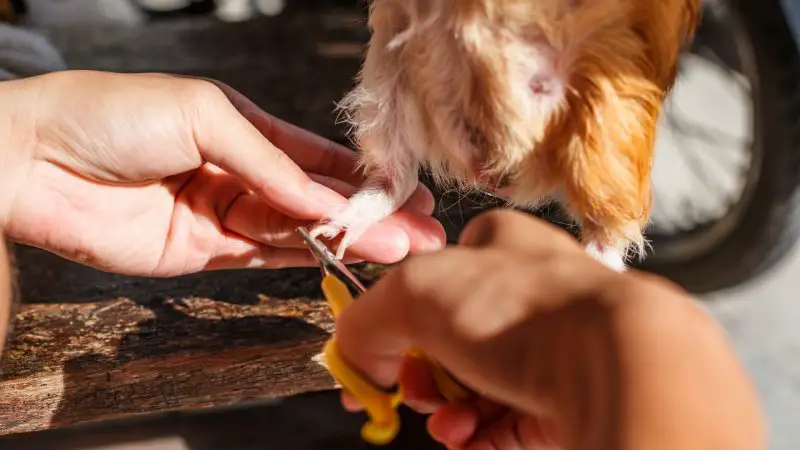
The only other thing you would need to do when it comes to guinea pig care tips is to trim its nails. Once a month is quite enough. Use a pair of toenail clippers. Ideally, there should be two people doing the procedure. It will simply be much easier. But if you want to try and handle everything on your own, a dry towel can help.
Wrap your pet in a ‘burrito’ and hold it under your armpit to make sure that both of your hands are free. These cute animals usually handle only a few nails at a time, so be patient. You can give your guinea pig some of his favorite treats to distract it from the unpleasant process.
If you always give treats to your pet after trimming its nails, a few months later, the guinea pig will learn to sit quietly in anticipation.
If you accidentally pushed on a blood vessel, a styptic pencil or styptic powder can help you deal with the problem. You can easily find those in any pet shop. You can always use a simple paper towel. Gently push on the cut nail for a couple of minutes, then the bleeding will soon stop.
Dental Care
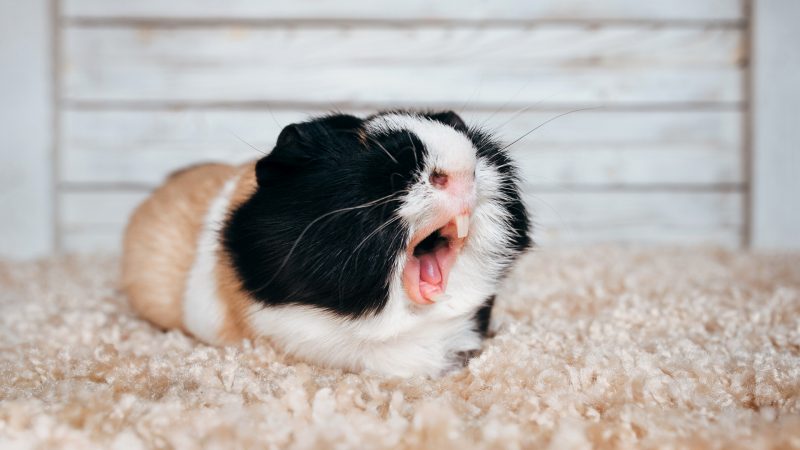
Dental care is something you should take into consideration. Did you know that your guinea pig’s teeth grow their whole life? Mother Nature has come up with such a mechanism simply because these fluffy animals wear down the surface of their teeth by continuously chewing. But that might simultaneously become a problem.
If your guinea pig has nothing to chew on, his teeth won’t be wearing out properly. That will lead to decreased appetite and pain while chewing. You should certainly see a veterinarian in such a case.
To make sure that nothing like that happens, buy high-fiber hay for your pet. Dry pellets may not always do the job properly as they are crumbly.
7. Common Diseases and Treatment
You never want your tiny friend to suffer. But, unfortunately, there are plenty of diseases that are common in guinea pigs. Some of them are the following:
1. Scurvy
This disease is caused by vitamin C deficiency. You should be aware that it is impossible for guinea pigs to store vitamin C in their bodies. That’s why giving a one-time dose of the vitamin and hoping for the best is not going to work. Your pet has to be getting enough vitamin C daily.
Symptoms of scurvy include joint swelling and stiffness. At one point, your guinea pig might start hopping like a rabbit because its back legs are no longer listening to it. Moreover, vitamin C deficiency makes the animal vulnerable to various infections.
2. Respiratory Infections
The symptoms include lack of eating and movement, coughing, sneezing, and discharge from the eyes and nose. The problem with respiratory infections is the fact that they are extremely common. Guinea pigs spend practically all of their lives in an environment full of small particles that they breathe in. As a consequence, their lungs, noses, and throats suffer.
3. Abscesses
These things are formed when your guinea pig suffers from some sort of infection. If you notice that a certain area has become swollen and there is a lump, it is an abscess. It can develop both under and on the skin. The vet can easily drain and dress the area properly.
But if you have spotted that the abscess has burst, you can use tape to cover the wound after disinfecting it. Make sure to give your pet a little more vitamin C than usual, so that its body is able to fight what is left after the infection.
4. Lice
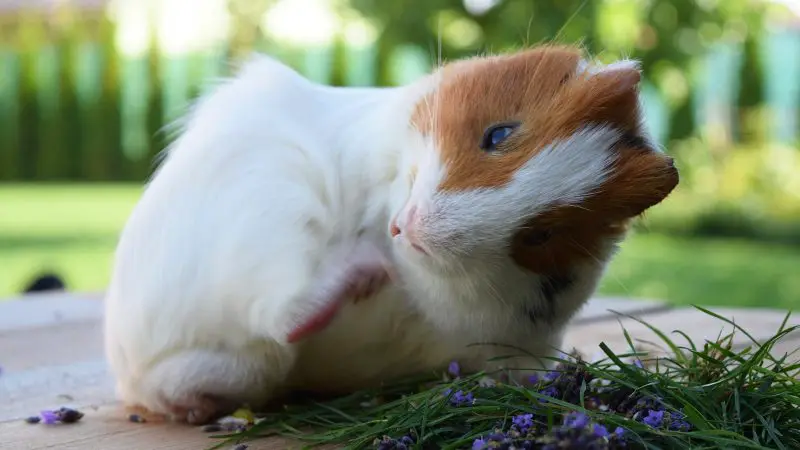
One of the most common problems. Lice are tiny insects that live on your pet. Even though they live off the skin and don’t suck blood, they can still cause a lot of inconvenience to your guinea pig. Your pet might develop an allergy, its body may be itching and as a result, a guinea pig will start biting itself.
Fortunately, nowadays, it is easy to get rid of lice. Using a special medical shampoo while bathing will do the job just fine. But remember that lice are extremely contagious. That’s why you have to wash all your guinea pigs, as well as their cage and hutches to ensure that they don’t get contaminated again.
5. Diarrhea
Even though we are used to the fact that diarrhea is not a serious illness, in the case of guinea pigs, it might become a huge problem. A severe case of diarrhea can have painful and dangerous effects on your pet. Usually, this illness appears after a change in a guinea pig’s diet. Sometimes, simply eliminating certain products from its daily menu is enough.
Diarrhea might appear right after you get the animal from a pet shop. It is a good idea to give the guinea pig the same food that he used to eat in the shop at least for the first few days. The transition to a new diet has to be slow.
Mild diarrhea treatment is simple. Make sure that your guinea pig eats only hay and water for 4-5 days. Severe diarrhea may be a symptom of a more serious illness, so paying a visit to the vet is a great idea.
6. Heatstroke
The majority of guinea pigs have thick fur. Moreover, they are unable to sweat. That is why it is extremely important to make sure that your pet is not exposed to direct sunlight, especially during summer. Even such temperatures as 25-26 degrees Celsius might become a reason for a heatstroke.
Keep the guinea pig in a cool place. If you have noticed that it is lying down and breathing rapidly, bring some cool water to sprinkle on your animal. Make sure that the cage has shaded areas where the guinea pig can rest from time to time.
7. Bladder Stones
Also sometimes referred to as ‘uroliths’. These stones often form in the bladder of pet guinea pigs. The urine becomes bloody because of the irritation. The little guy feels pain and discomfort. Bladder stones have to be surgically removed.
8. Ileus
Basically, the ileus is when gas builds up in the stomach and intestines. The gas is unable to leave the body and causes discomfort. This condition is developed when your guinea pig stops eating. This may happen due to a variety of factors.
These animals can easily get stressed and this might become a reason for their lack of appetite. Simply moving your pet’s cage can be stressful. Ileus can also develop because of other diseases that cause discomfort to the guinea pig.
Annual physical examinations will help you ensure that your beloved pet is healthy. Keeping a close watch on the behavior of the guinea pig is extremely important as well. Make sure that it is eating and defecating, that it’s active, and has clear skin and fur.
Wash your hands before and after picking up guinea pigs. The environment in which the guinea pig lives has to be safe for his health. Freezing his bedding and food before use is also a great measure for disease prevention.
8. Guinea Pig Breeding
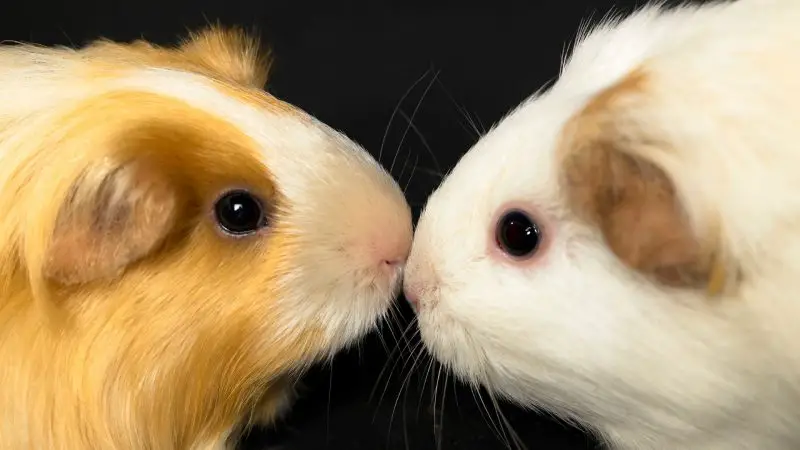
Female guinea pigs can also be called ‘sows’ and males are ‘boars’. To know if your guinea pig is a boy or a girl, hold your pet belly up, and don’t forget to support its back. In adult males, the testicles can easily be seen. They will also have a slit right above the anal opening. On the other hand, female guinea pigs have a skin fold in a ‘Y’ shape above the anal. Also, they have an external urethral opening.
Vets usually do not recommend individual pet owners attempt breeding their guinea pigs. Before doing that, make sure that the babies will have a loving home and won’t be simply thrown away.
You should also bear in mind that breeding decreases the lifespan of female guinea pigs. Starting to breed after 8 months of age can simply be dangerous for the sow. That happens because of the fact that in adulthood, female develops a normal stiffening of the joint of the fibrosis cartilage between the pelvis and the two pubic bones.
Guinea pigs reach sexual maturity at around 10 weeks of age. But vets advise attempting to breed the pets after they reach 3 months of age.
A female guinea pig’s heat lasts 16 days. The best way to make sure that your guinea pig’s mate is simply by leaving them together until you are sure that the girl is pregnant.
Pregnancy
The pregnancy lasts up to 70 days. The female guinea pig will be able to produce from one to six babies. 2-3 is considered to be the average number of litter. The sow has to be given additional vitamin C during the pregnancy period.
Moreover, as the female guinea pig will most certainly double in weight, you have to be able to provide more water and food. Don’t make any changes in the cage during the pregnancy period, as the female might get stressed out.
The actual delivery lasts for about an hour and is not at all complicated. Stillbirths and abortions are, unfortunately, common with guinea pigs and there isn’t anything that you can do about it. The mother will clean her children on her own. The placenta will be shortly eaten by the mother herself or any other guinea pig.
It is important to remove the sow from other guinea pigs before the female starts giving birth. Firstly, it is for newborns’ safety. Secondly, the sow might get pregnant again practically right after giving birth. It won’t be great, as the mother simply won’t have enough strength to take care of all the babies.
9. How to Pick up Your Pet?
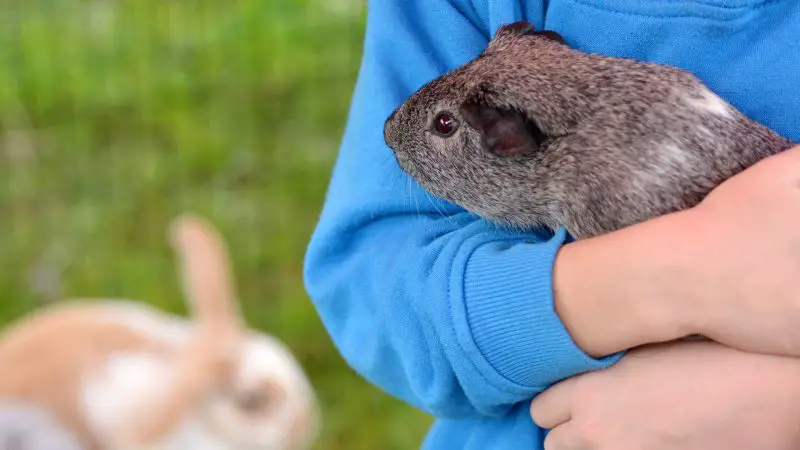
Don’t forget to come up to the guinea pig from the front. Place one hand under the chest and the other one should be used to support its hindquarters. Bring the little guy against your chest so that it feels secure.
It is recommended to hold your guinea pig for not longer than 15 minutes, as the animal would naturally need to use the bathroom. But picking up your pet and talking to it is very important, as it helps create a bond between the owner and the guinea pig.
Soon the animal will start trusting you and will happily respond to your strokes. Gentle neck rubs and strokes between the ears are often appreciated. The tummy area, however, is a vulnerable zone where not all guinea pigs like to be touched.
Remember that guinea pigs like to be treated gently. They have sensitive inner organs and delicate bones. It is normal for these animals to feel anxious and nervous. Moreover, they are programmed with strong jumping habits, so do everything you can to prevent any type of injury.
